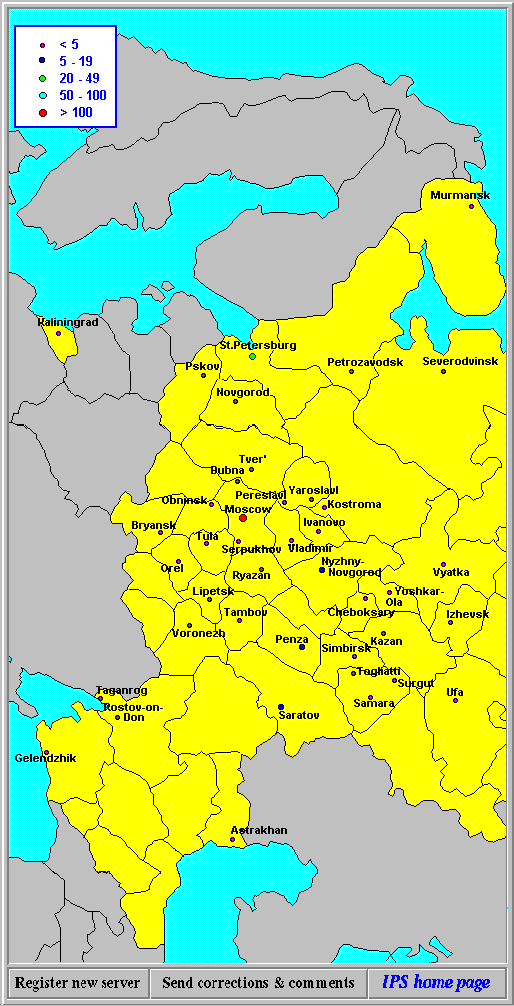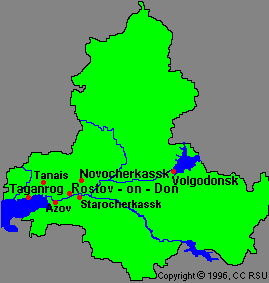|
|
||
 |
|
 |
|
|
||
 |
|
 |
Our American team flew 10 hours to Moscow, then we flew 700 miles south to Rostov Na Donu, our destination city. Rostov is a city of about 1 million people, nestled along the Don River region not too far from Ukraine and the Black Sea. Rostov, like just about every city in Russia, has been struggling economically since the fall of communism, and there is a wide disparity of incomes; you don’t really see an economic middle class. It’s hard to see such well educated people struggling to make ends meet. The average teacher makes less than $50 a month.
Russian History
There is a heavy emphasis on history here, as Rostovites frequently celebrate their Cossack roots and emphasis on a military culture. I spent one morning in neighboring Novocherkassk, 25 miles north and got an informative tour of this historic “town” of 200,000. Both Rostov and Novocherkassk boast themselves as the center of Cossack history. The Don Cossacks had the reputation as staunch defenders of Russia’s southern border and even fought against Napoleon. Today there is a resurgent interest in public functions and military parades where they flaunt their uniforms and processionals. And you can’t avoid memorials about the Great War (WW II). Between the War and Stalin’s pogroms, I’ve heard estimates between 20 million and over 50 million lives lost. This sense of loss has never left the hearts of Russians.
(For
more information on Rostov and its history.)
Western Team
|
|
We were a solid team of 14: 9 American small group leaders, 2 Canadian trip directors (husband and wife), and 3 Russian nationals. It was a pretty seasoned group, in which I was the youngest American. Several team members knew one another and several had participated in months-long CoMission follow-up trips in various Russian cities. Since my last trip to Russia or Ukraine was 7 years ago, I was a little rusty and grateful for the pool of experience on our team. |
Character Development Seminars
We spent 11 days in Rostov, which gave us much more time than the 4 or 5 days spent in my 1993 trip there. Our ministry focus was to about 65 public school teachers who were interested in further training in a curriculum in morality and ethics based on the Bible. God was gracious to allow us to meet with many new friends and to reunite with some old friends from our first convocation in June 1993. In less than 2 weeks, we developed warm relationships with teachers and they felt comfortable enough with virtual strangers to share personally about their lives and their spiritual journeys. This pattern has been repeated in countless trips over the past 10 years, and God has clearly worked through this. Later on, I’ll share some stories about some special individuals I met.
Our Schedule. If you’ve never been on a missions trip, you might wonder just what people do each day. Here’s a sampling: During the first week of our stay, we met with small groups of local schoolteachers and other educators for 2 hours on each of 3 successive evenings, focusing on lectures and lessons in the curriculum, as well as lessons and practice in the inductive Bible study method. In the second week, we met with our small groups on Monday evening solely to get to know one another better and to meet as Bible discussion groups. We then had 2 nights off to go to the theater and have dinner with our team or teachers. Our final night with the teachers, Thursday, was an emotional “Farewell Tea” in which we drank chai (tea), shared gifts, took photos, and each group presented a talk or song before the entire room.
During the mornings we held team meetings, and the afternoons were free for school visits, wandering around the city, or preparing for the evening’s activities. At first I chafed at this loose schedule (the J’s of the world can understand), but I realized we needed the open afternoons to allow relationship building and to replenish our energy for the evening. You forget how much the culture and time difference tires you out.
Small Group Meetings. In previous convocations as well as these Character Development Seminars, we found that meeting in small groups was the best way to build relationships, distribute materials for the teachers to take home with them, and model Christ’s love to the Russian people. I much preferred this personalized approach, and let our team director and other speakers lead lectures from up front. They shared about innovative teaching methods, the reliability of the Bible, and an overview of each night’s lessons.
As in previous trips sponsored by Campus
Crusade for Christ’s International School Project, we loaded teachers up
with Christian materials each evening. Here’s a cross section of
what we gave Russian participants over the 5 nights, and believe me, they
eagerly took everything we gave them:
I wish I had a copy of the curriculum
to show you (we gave them all away). Whether in Russian or English,
it is excellent and any Sunday School or Christian School teacher or Bible
Study leader in the United States would get plenty of meat from it.
If you saw the early versions of the curriculum 10 years ago, the current
version shows the hands of experienced curriculum writers and the Lord’s
blessing.
If you would like to know more about the International School Project or if you would like to go on a missions trip with them, go to http://www.isponline.org. You can also read more about Campus Crusade at http://www.ccci.org.
If you click on either
map below, you will be taken to the site that map was taken from, and can
see clearer versions of the maps.


Home
| Support
Letter | Trip
Overview | Answers
to Prayer | Sights
and Sounds | School
Visits | Churches
| Beginnings
and Endings
[email protected]